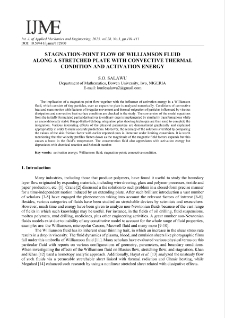Zielonogórska Biblioteka Cyfrowa udostępnia 65 391 obiektów cyfrowych
Obiekt
Tytuł: Stagnation-point flow of Williamson fluid along a stretched plate with convective thermal condition and activation energy
Współtwórca:
Tytuł publikacji grupowej:
Abstract:
The implication of a stagnation-point flow together with the influence of activation energy in a Williamson fluid, which consists of tiny particles, over an expansive plate is analyzed numerically. Conditions of convective heat and mass motion with features of irregular movement and thermal-migration of particles influenced by viscous dissipation and convective heat surface condition are checked in the study. ; The conversion of the model equations from the initially formulated partial derivatives to ordinary ones is implemented by similarity transformations while an unconditionally stable Runge-Kutta-Fehlberg integration plus shooting technique are then used to complete the integration. Various interesting effects of the physical parameters are demonstrated graphically and explained appropriately in order to make accurate predictions. ; Moreover, the accuracy of the solution is verified by comparing the values of the skin friction factor with earlier reported ones in literature under limiting constraints. It is worth mentioning that the velocity profiles flatten down as the magnitude of the magnetic field factors expands but this causes a boost in the fluid?s temperature. The concentration field also appreciates with activation energy but depreciates with chemical reaction and Schmidt number.
Wydawca:
Zielona Góra: Uniwersytet Zielonogórski
Format:
Identyfikator zasobu:
DOI:
Strony:
Źródło:
IJAME, volume 28, number 3 (2023)
Jezyk:
Licencja:
Licencja CC BY-NC-ND 4.0:
Prawa do dysponowania publikacją:
Biblioteka Uniwersytetu Zielonogórskiego
Kolekcje, do których przypisany jest obiekt:
- Zielonogórska Biblioteka Cyfrowa > Repozytorium > Jednostki organizacyjne > Wydział Mechaniczny
- Zielonogórska Biblioteka Cyfrowa > Repozytorium > Typy utworów > Artykuły
- Zielonogórska Biblioteka Cyfrowa > Repozytorium > Czasopisma naukowe i serie wydawnicze UZ > International Journal of Applied Mechanics and Engineering (IJAME)
- Zielonogórska Biblioteka Cyfrowa > Repozytorium > Czasopisma naukowe i serie wydawnicze UZ > International Journal of Applied Mechanics and Engineering (IJAME) > International Journal of Applied Mechanics and Engineering (IJAME) (2023)
Data ostatniej modyfikacji:
30 paź 2023
Data dodania obiektu:
30 paź 2023
Liczba wyświetleń treści obiektu:
174
Wszystkie dostępne wersje tego obiektu:
https://zbc.uz.zgora.pl/publication/84360
Wyświetl opis w formacie RDF:
Wyświetl opis w formacie OAI-PMH:
| Nazwa wydania | Data |
|---|---|
| Stagnation-point flow of Williamson fluid along a stretched plate with convective thermal condition and activation energy | 30 paź 2023 |
Obiekty Podobne
Salawu, Sulyman Olakunle Okedoye, Akindele Michael Jurczak, Paweł - red.
Fenuga, Olugbenga John Hassan, Anthony R. Olanrewaju, Philip Oladapo Jurczak, Paweł - red.
Fenuga, Olugbenga John Hassan, Anthony R. Olanrewaju, Philip Oladapo Jurczak, Paweł - red.
Narender, Ganji Sarma, Sreedhar Govardhan, K. Jurczak, Paweł - red.
Jauhri, Shefali Mishra, Upendra Jurczak, Paweł - red.
Reddy, Shashidar Borra Reddy, B. Narsimha Saritha, Kallu Chesneau, Ch. Jurczak, Paweł - red.
Gururaj, David Maxim Anthony Sundaram, Dhanasekar Parthiban, V. Jurczak, Paweł - red.
Garg, P. Purohit, G.N. Chaudhary, R.C. Jurczak, Paweł - red.

